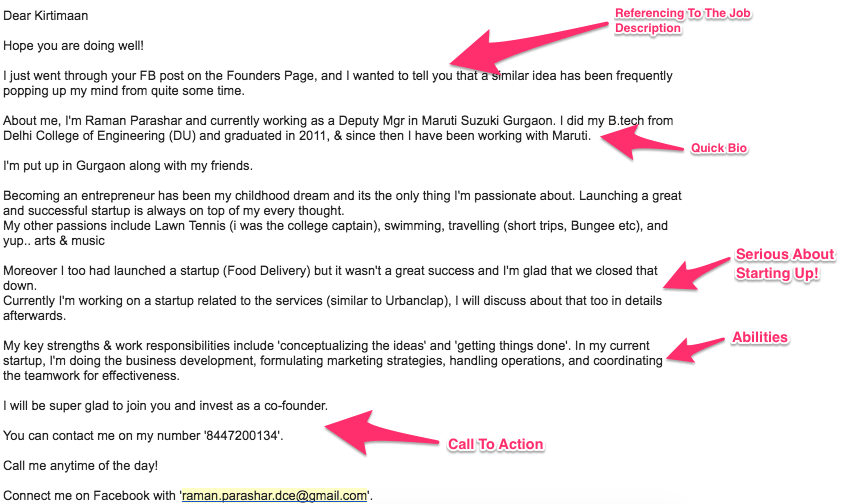
If you’re reading this, you probably know that finding a co-founder can be tricky business.
Some entrepreneurs are lucky enough to start their company with somebody they knew beforehand. It’s great having a friend by your side, but the most important thing is to have someone who complements your skill set and shares your vision and is willing to take the leap with you. So what can you do if nobody you currently know matches that description?
Where do you go? Who do you ask for help? Do you find help on Google? Or Facebook? Or do you just read hastily written listicles like ‘5 ways to get blah blah co-founder’ on tech sites?
Well, this is exactly the situation I was in about one and a half year ago.
I was trying hard to start a company but I couldn’t catch any luck in finding a business partner. I’d spent countless hours surfing the internet and my time reading one useless article after another, I couldn’t find anything but fluffy feel-good material with no real advice.
Without putting much thought into anything, I started reaching out to all sorts of people and started convincing them to join me in my mission. I met some people who had great potential. People who were perfect for my business, but their responses to my proposition were…
- “Oh I like your idea but I won’t be able to work full-time on it.”
- “The idea is great but I don’t have the time and money to invest it.”
- “I am getting married next year. I don’t think it is the right time to work on something like this.”
- “I can only work on this after office time.”
What they were really saying was “I can’t come to work with you because your offer is not compelling enough for me to leave my high paying cushy job.”
As I kept on meeting more and more people, I realized that I needed to tweak my approach because I wasn’t getting anywhere.
It was during this trial and testing phase that I stumbled the blueprint which had instructions on how to find a co-founder in a matter of 30-90 days. In the following guide, I will share the lessons from this blueprint as well as my own personal experiences.
Now if you are reading this, I am sure you are someone who is trying to start a company or has a product which has some level of traction, and you are looking to find your perfect one.
First and the most basic thing that you need to understand is that it is very important to reach out to as many people as you can to find a co-founder.

(So the more people I reach out to, the more my message gets spread out and it will bring in more people to my Funnel)
To help you understand the process, I’ll be covering the following things:
- How I learned to hire a startup co-founder
- Mistakes most founders make when hiring a startup partner
- My step by step process for hiring a co-founder
This is is a pretty lengthy guide and it can get a bit overwhelming, but I guarantee this is the most helpful guide you’ll come across online. If you follow sequentially and diligently, you are bound to get results.
How I learned to hire a startup co-founder
After about eight weeks of multiple rejections from friends and acquaintances, I got in touch with Nikhlesh Tayal who runs a website that deals with senior level hiring for startups.
Nikhlesh has years of experience in the field and has developed a relatively simple framework when it comes to hiring. I started following his framework and developing content which would help me attract high-quality talent. And in a matter of 30 days, I had found my co-founder who was more than willing to work with me.
Once I cracked the nut, I realized that startup hiring is very different from other types of regular hiring. It’s extremely challenging to make people excited about a small company that they’ve never heard of.
Think of it this way: If tomorrow Uber has to do a senior level hiring, they can do it easily because they have the money and muscle to do it.
And more importantly, Uber today is as big as any public company, so the trust level is really high with potential recruits.
But it is tricky when you have fewer resources to work with.
So, I created a job description which attracted high-quality talent from all across the country. Here’s the link to the post. It got me so many likes, shares, and comments that I still get emails referencing this post.
And not only that, this single post helped me attract potential senior employees, my tech co-founder and other key hires as well.
Mistakes most founders make when hiring a startup partner
I don’t know if this is the case for every media platform, but Facebook and other top forums like Reddit have a simple rule: The more engagements — likes, comments, and shares —your posts have, the more they will be promoted.
But unless you phrase your message the right way, it will never get that sort of attention. In other words, your post will probably never get noticed by the right people. Some mistakes to avoid here:
Mistake #1 Half-hearted effort:
Most of the posts that you see on forums start with ” Looking for a rockstar co-founder” or ” looking for a passionate co-founder” and are rather short.
If you are looking to attract some serious talent, please refrain from using buzzwords and focus on being creative and unique. Also, you will probably need more than 20-30 words to properly convey your message. Make it unique so that it gets more engagement and stands out among other posts.
Mistake #2 Not sharing your idea:
You should be ready to share some details about your idea in order to attract the right set of people.
If for instance, you are working on an idea featuring AI-powered technology for the automotive industry, you should include those details in order to reach potential founders with knowledge of those particular industries.
Mistake #3. Jumping in too early:
This is the most common mistake. Finding a business partner is almost like finding a life partner: Sometimes we overlook minor flaws because we are infatuated with other, more dominant traits.
The idea is not to hurry but to approach the selection process with calmness en caution.
Start with a trial period to see how the other person can add value and if you work well together. If not, keep looking for a more suitable match; don’t settle on low-hanging fruit.
Step by step process for hiring a co-founder

(Click here to enlarge this image)
The whole process of finding a co-founder can be done in a matter of eight easy-to-follow steps. I have tried to make the process as detailed as I can so that you can read and apply it step by step.
Brand building
The number one reason why it is so hard to find a co-founder or a senior level person for your startup is that very few people will know about it. Founders and startups usually don’t have any credibility in the market because to the outside world, you are just another website on the internet.
And this is exactly what you need to work on.
You need to start building your own and your startup’s credibility by getting featured in media and publications. Start by getting your story out there — for example by sharing your personal story or your company’s vision.
As you do that, more and more people will get to know about you and your brand and that will eventually get people to trust you more as a brand.
Media mentions will add social proof to you and your company.
There are few tactical steps which you can use for building your brand:
1: Story section (website): Instead of writing a boring ‘about us’ section on your website, you should write something that’s interesting and unique; a note that speaks to your readers on a personal level.
People love stories: It’s the often the only way they remember things and it’s definitely how they remember brands. So if your story is good, your reader will remember it well.
In addition, a well-written “about us” section helps filter out non-serious candidates and applicants who don’t meet your requirements. So by being clear about who you are, you will attract the right candidates while repelling the wrong ones at the same time.
This is the first level where you should start eliminating all the mediocre candidates.
Your “about us” section story should cover the following:
- What have you done till now?
- Why are you solving this problem?
- Why are you the best person to solve this problem?
- How did you come up with this idea and why now is the right time to solve this problem?
Also, share some information about the evolution of the product.
One thing which I did well with my startup website: I clearly mentioned in our “about us” section what kind of people should join us and what kind shouldn’t join us. This helped me attract the right kind of applicants who were fit to work in a high-pressure startup culture.
For more inspiration, here are some examples of how very successful entrepreneurs present their company and vision:
a) Travis Kalanick (Uber, co-founder) mentions offering job opportunities:
When sharing Uber’s story, Kalanick always mentions that he wants to create low-cost transportation and generate jobs in different cities of the world.
Click here to get access to his story
b) Mark Zuckerberg speaks about connecting the world:
Zuckerberg often talks about connecting the world as his number one vision: and that’s where he is moving the whole company and its products. The products Facebook builds aim to get more and more people on its platform.
Click here to get access to Zuckerberg’s story.
c) Elon Musk speaks about building a sustainable future:
Click here and here to get access to Musk’s story.
These stories are simple and easy to communicate and that’s what you need to do too: Create a story that’s inspiring and that draws people into your culture and the work you do.
You can learn more about hiring people and creating a story for your company from serial entrepreneur Sameer Guglani:
(Please watch this video to the very end. If it doesn’t work, please click here to get access to the video.)
2: Getting PR/media mentions
To get PR for your startup, you should read this great article by Noah Kagan From Ok Dork, and some material from Neil Patel as well.
Creating an irresistible job description
Once you understand how to position yourself as a brand and write a great story for your prospective hire, then the next step is figuring out how to create a salesy co-founder job description post.
But before we get into that, let me ask you a quick question: Have you been on any of the startup forums on Facebook? The ones where people look for co-founders?
If you visit these forums, you’ll notice that founders are writing messages of about 50 words that often look like these:



Notice how the messages don’t convey anything specific here. When writing a co-founder job description, make sure that it flows like a story and covers things in an end to end format.
Another mistake many people make is that they only focus on what type of co-founder they need, without giving detailed information about themselves or the company. So make sure the job description also includes information about you and your brand.
Your potential co-founder can get a decent position anywhere, so why should they pick you? That’s what you should focus on.
To me, creating a co-founder job description post is slightly different than your average post. When I crafted my post, it took me a lot of time and several revisions to figure out the final draft. You can view the result here. And here’s another one for reference.
What I have realized is that a perfect job description should have these key elements:
- Story: The job description should be an insight into the kind of person you are. What you have done in the past, your accomplishments (even if they are small), your failures (don’t be afraid to show vulnerabilities) and combine them in an easy to read story format, just like you do in your interviews.
- Why you are the best person for this job: Explain why you are working on this opportunity right now and why you are the right person who can solve this problem better than anyone else. Get as detailed and as specific as you can.
- Inspiring: The undertone of the job description should be inspiring, something that evokes interest in the reader and makes them read end to end.
- What they’ll get: Be specific on what’s in it for them, instead of focusing on your benefit. When you craft your story like a sales pitch, people will feel as if you are speaking directly to them. Persuade them to buy into your story.
- Who would be a good fit: It’s important to clarify who you envision for the position. When I wrote my blog post, I made it specific enough to only attract the right people. I mentioned 4-5 requirements and that helped me eliminating substandard applications.
- Who wouldn’t be a good fit: This part is even more important. Please make this section really specific so that you only attract serious prospects to your posting.
By following these steps you set expectations upfront. That way, people know right from the beginning what they are signing up for. If you have written a detailed, clear-cut job description, odds are that it will help you find who you’re looking for.
Job posting
By now, you will probably have created a first draft or at least a good enough revised edition for your co-founder job description that will attract the right sort of audience. Once you have created a draft, I’d recommend you share it with your startup friends and ask them for feedback. This will offer a “real world” feel of how people are responding to your post. I’d recommend to reach out to 10-20 people for feedback on the job description.
Hiring for a startup is hard. It means finding talented people who are willing to commit time and energy to building a company. Those people are rare.
So instead of looking for them on conventional job portals, you should get more creative. The question is: Where can you source high-quality co-founder applications?
Usually, people who are crazy about working for startups can be found on the following forums:
- Facebook startup groups: Find all the startup groups and forums in your city and/or country and share it your job posting there.
- Reddit forums: Search for local startup pages and co-founder forums on Reddit.
- Tech forums like Hasgeek
- Co-founder hiring forums: Co-FounderLab, FounderDating, etc.
- AngelList: Lately, AngelList has been a great platform for startup hiring.
- Paid advertising: You can run ads on Facebook and LinkedIn with a budget of $100 each, and you’ll get high-quality applications.
- Alumni: Sharing your job post in your alumni groups can be really powerful; you’ll find a lot of interested prospects there.
- Referrals: Referrals and asking your friends to share can be very helpful. If you are able to get the right people to share your job posting, you’ll get a lot of high-quality applications.
By asking people who are (more) active in the startup community to share your post, chances are you will get high-quality applicants in your funnel.
Adding simple things to the post, like asking people to share the job description, can do wonders for you. For example:“ It would be great if you could share this post on your Facebook and LinkedIn, as it will help me reach out to the right people.“
Once the distribution part is done, our next task should be to filter out bad applicants.
But how do you filter out bad applicants?
By introducing qualifiers in every step, which you can do right away in the job posting stage.
Now I created a simple qualifier for my job posting. This qualifier was necessary as it separated top performers from the average ones.
In the last line of the job post, I specifically mentioned how to apply:
“ How To Apply:
Tell me your story, Why would you like to join us, what excites you about this venture,, what do you do for personal growth, what is your skill set? What have you worked on in the past?
Don’t expect a reply if you simply send in your CV or ask questions in the comments section below. We want to know who are you and if you share the same vision or not and have the right skill set for it. Send an email at [email protected] or [email protected] “
Although I had made it clear in the application process I wanted applications in my inbox, many people still responded through comments, messages, calls, and in other ways. So I pointed them in the right direction and asked them to follow the process yet very few of them sent me an email.
But then I realized this actually shows the difference between great applicants and average applicants.
The best applications I received were the ones that landed straight in my email box. To give you an idea: Once I ran the ad posts in several communities and ad spaces, this is what my final stats looked like:

(Application statistics)
- I got about 200 odd applications.
- 52 Emails.
- 15 calls/meetings.
- 8 in-person meetings
- 2 shortlisted candidates for trial
- 1 final recruit
Qualities to look for in a potential candidate
If you have done the job posting part correctly, you’ll see a lot of applications coming at you via email, calls, messages chats and other types of requests on all your social platforms from people wanting to work with you as a co-founder for your startup idea.
Now, before you commit to working with someone, you should always take it slow. If you’re not sure about someone, don’t commit. There is no test to measure this, so go with your gut feeling. If it doesn’t feel right with this person, you’ll probably run into problems in the future.
Trust your intuition. When it’s the right person, you will know right from the first point of contact.
However, there are some methods you can use to weed out unfit prospects.
You can test certain things:
a) Email: If you observed my job description process, you should add the application process through email only. Only the applications that are sent via email will be accepted.
So, you should look out for the emails that you receive.
Observe the email, how well structured is it, grammar usage, sentence structuring, and other qualities that stand out.
This is what a proper email looks like:

b) Intro meeting/call on short notice:
Again, this is something to take into account during the process. When reviewing someone’s qualities, always check if the person is fast-paced and adaptable, because working in a startup environment means making quick decisions.
You can list down all the qualities that you are looking for and test the person. In my case, however, I opted for the “quick call method.” To check whether the person was right, I asked to meet or get on a call with them as fast as possible.
Now the intention isn’t to actually conduct a proper interview yet, it should be more of a “get to know each other” kind of call/meet.
The idea is to see how responsive and proactive the person is. If your applicant can’t respond promptly to urgent calls or meetings, it will become difficult for him/her to work in a fast-paced startup environment.
Also, the faster the response, the more willing the person is to join the startup.
c) Discussion about the product:
Now, this is a very subjective topic, but as a founder, I believe you can understand this better than anyone else. When you speak to your prospect, try to get into deep, meaningful discussions about your product.
If you’re at the product stage or traction stage, ask them how you can improve a certain part of the product, depending on who you’re recruiting.
And if you are still at the idea stage then ask them for cues on how to build the product and how you can evolve your idea into a minimum viable product.
Notice the kind of quality and valuable inputs they add to the discussion. A capable person will always stand out, even during the first interaction phase.
There will be times when the person you meet looks great on paper but seems ‘meh’ when discussing your product —and the opposite can be true as well. So think of this discussion as a test.
First interview
I believe that by now, you have filtered out unfit candidates so that you are left with only high-quality candidates.
Now you need to figure whether you and the candidates you’ve selected are a mutual fit. And that’s what this first meeting will be about.
The meeting should have informal structure, a sort casual meet-and-greet. The reason why I suggest this is because you want the other person to open up and talk about things which you wouldn’t talk about in a normal interview.
Try to ask questions that come naturally to you. Again, try to avoid the tone of a formal interview.
Instead, ask basic questions like:
- Why do you want to join me as a co-founder?
- Do you think you’re at a stage in your life where you can partner up in starting a company?
- What are your plans for the next five years?
During this meeting, ask them what they expect in terms of role, job, responsibility, capital contribution (if you are looking for it), ideas, and cultural and/or core values.
In my case, there were a few things which I couldn’t compromise on. I wanted the following things.
- Similar mindset
- Trust
- Cultural values
For me, these things were super important.
Assigning a project
Having casual one-on-one meetings with your potential prospects is the best way to find a mutual fit. Once you have done that, you should test the person is in terms of deliverability. Assign a small project to them and see if they can deliver on it.
You could, for example, have them work with you and your team for a period of one week. But there are other ways as well, such as asking them to design a 100-day roadmap of the division which they will be taking care of. This is a great way to test their skill set — a teaser of what to expect if they come on board with you.
A good way to estimate the level of proficiency is by reviewing the report’s quality. Does it have clear specifics, timelines, resources required and what will be the end deliverables look like?
Another possible assignment is to have them focus on product growth. Ask them to prepare a plan on how to grow the product to 100,000 web views a month, or getting 100,000 users by the next month, with $0 marketing spend.
Similarly, you could create such projects for other divisions as well and test your candidate’s proficiency level. This will help you differentiate between a seasoned manager and a newbie.
Reference checks
Once your prospect has passed the 100-Day roadmap test, you can then test whether you want to work with the person or not. If the answer is yes, do a reference check on your potential new co-founder.
This will establisher a clearer picture and helps you decide if you want to work with the person or not.
In my experience, the best way to do background verification is through LinkedIn connections and third-party agencies like KPMG Global.
If that’s not an option, then you can google “employee verification agencies or companies“ and you’ll find a lot of companies who can help you with it.
There are two types of verifications which you can do here:
a) References provided by applicant:
To do a reference check, first, speak to the contacts provided by your applicant. Speak to them about your prospect’s ability to execute your plans, and ask if this person would be a great fit culturally.
Talk to a minimum of three people.
b) Cold references:
If you prefer, cold references can be done by agencies. But if you want to take charge of it yourself, reach out to some of the people in your prospect’s LinkedIn contacts.
Try to avoid speaking to people who have given testimonials/recommendations to your prospect; they’ll be inclined to give biased reviews and will probably inform your prospect as well.
Prepare a list of questions which you think are important for you and ask them for a quick chat.
Onboarding
By now, you have narrowed it down to a list of one to three candidates. To move forward, ask your favorite candidate to work with you for 7-15 days with no pressure and no expectations. If it works out fine, you can continue working with each other and discuss compensation and other benefits. If not, move onto other candidates.
Discussing equity, vesting rights, and shareholder rights are irrelevant at this point. Those things should be discussed once you know what it’s like to work together and are sure you want to continue this partnership.
Once the trial period is over, then give them an offer. You can use tools available in AngelList to offer them a fair share of equity, compensation, benefits and vesting period details.
Try to include them in the discussion. Ask them what they think is a fair compensation and offer them something that’s a little higher than the industry standard.
It’s very important they feel fairly compensated. If not, this issue can pop up later and cause problems for you. So try to work out something that’s fair for all the parties so that they feel motivated for the cause.
Think about it. If you are getting a highly skilled person on board, what are they sacrificing? Are they sacrificing money? Are they sacrificing in terms of their career growth? Are they sacrificing in terms of their personal life?
If they are making sacrifices, like you, they deserve to be rewarded properly.
You could do the following to get them properly onboard in your company:
- Adding to company communication: Slack, email, Trello, Google apps, etc.
- Sharing private folder: Folder like Google Drive, Dropbox, etc.
- Creating fresh logins for salary account, HR documents — offer letter, ESOPs letter, salary slips (when required) and other documents.
- Adding a new laptop and workspace.
- Sharing important documents related to business strategy
Conclusion
If you are starting out for the first time and struggle to find a business partner, I know it can get hard sometimes. Trust me, I’ve been through it all.
But as I have gone through the trial and error with my startup and after helping other startup founders, hiring a co-founder eventually comes down to how well you can display your value to your potential co-founder.
If you can do that, then hiring should be an easy peasy task. And although the full process does take some time, if you do it right it will definitely pay off.
For now, that’s all from my end. If you have questions or comments, please type them below in the comments section and I’d love to answer them personally.
Get the TNW newsletter
Get the most important tech news in your inbox each week.




